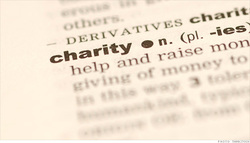
Have you ever been at the grocery store and they have food item or product at the end of the counter, then after they ring up your groceries, they ask: "Would you like to donate $1 for (fill in the blank) charity?". More often than not, most people say yes because, they have already purchased my groceries and hey, what is an extra dollar?
How about when you get that call on the phone to ask if you would please buy a magazine subscription at a ridiculously low rate to help a particular charity to raise money? Again, most people would sign up because well, they like to read and always wanted that particular magazine. Normally you would not subscribe to it as it is an unnecessary expense. But now it is for charity so, why not? You get the enjoyment of your favorite magazine and the charity gets the funds it needs.
These methods are just some of the ways that charities have instituted to help them to raise funds. Rather than ask outright, why not give people something that they may already want while asking for a donation. Retailers have similar way of working. Product Red aka (PRODUCT)RED was formed to raise awareness to awareness and funds to help eliminate HIV/AIDS in Africa.
And as most people know, pink products are what Avon has to raise awareness and funds for the fight against breast cancer. They have also introduced purple products for the fight against domestic violence.
Tastefully Simple has also joined the ranks of retail brands introducing products for charity. Their cause is Share Our Strength via No Kid Hungry campaign to fight against child hunger in America.
These are just some of the ways that charities try to make it easier for people to give. Whether it be beautiful clothes and jewelry or delicious gourmet food, charity can now be more than an annual event. Giving to charity is no longer something that is considered obligatory. You can give when you want, how ever you want and feel rewarded by not only in making the contribution, but getting something that you can enjoy as well. Charity can truly begin at home.